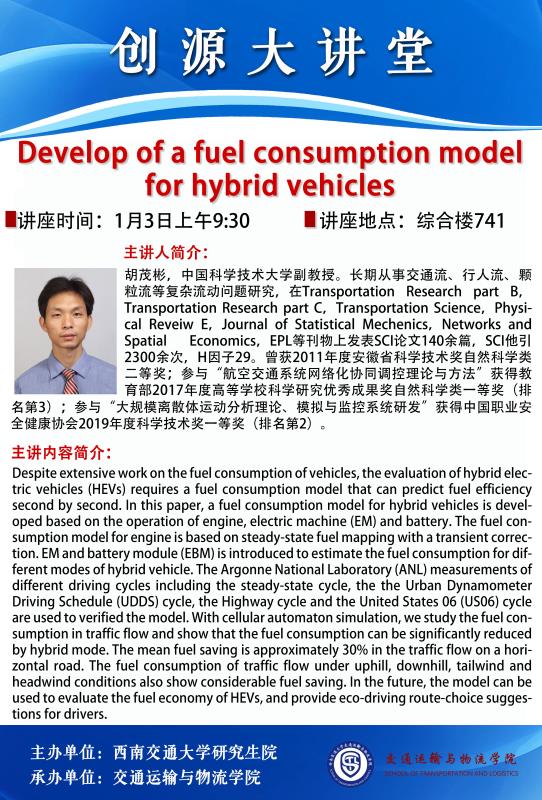西南交通大学
“创源”大讲堂研究生学术讲座
海 报
讲座时间:2020年1月3日
讲座地点:综合楼741
主讲人简介:中国科学技术大学副教授。长期从事交通流、行人流、颗粒流等复杂流动问题研究,在Transportation Research part B, Transportation Research part C, Transportation Science, Physical Reveiw E, Journal of Statistical Mechenics, Networks and Spatial Economics, EPL等刊物上发表SCI论文140余篇,SCI他引2300余次,H因子29。曾获2011年度安徽省科学技术奖自然科学类二等奖;参与“航空交通系统网络化协同调控理论与方法”获得教育部2017年度高等学校科学研究优秀成果奖自然科学类一等奖(排名第3);参与“大规模离散体运动分析理论、模拟与监控系统研发”获得中国职业安全健康协会2019年度科学技术奖一等奖(排名第2)。
讲座内容简介:Despite extensive work on the fuel consumption of vehicles, the evaluation of hybrid electric vehicles (HEVs) requires a fuel consumption model that can predict fuel efficiency second by second. In this paper, a fuel consumption model for hybrid vehicles is developed based on the operation of engine, electric machine (EM) and battery. The fuel consumption model for engine is based on steady-state fuel mapping with a transient correction. EM and battery module (EBM) is introduced to estimate the fuel consumption for different modes of hybrid vehicle. The Argonne National Laboratory (ANL) measurements of different driving cycles including the steady-state cycle, the the Urban Dynamometer Driving Schedule (UDDS) cycle, the Highway cycle and the United States 06 (US06) cycle are used to verified the model. With cellular automaton simulation, we study the fuel consumption in traffic flow and show that the fuel consumption can be significantly reduced by hybrid mode. The mean fuel saving is approximately 30% in the traffic flow on a horizontal road. The fuel consumption of traffic flow under uphill, downhill, tailwind and headwind conditions also show considerable fuel saving. In the future, the model can be used to evaluate the fuel economy of HEVs, and provide eco-driving route-choice suggestions for drivers.
主办:研究生院
承办:交通运输与物流学院
